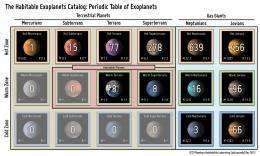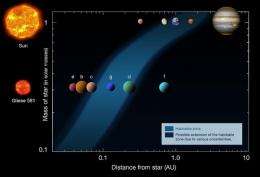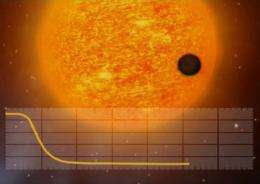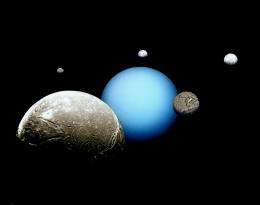According to the Planetary Habitability Laboratory's recently released periodic table of exoplanets, warm Neptunes and 96 warm Jovians lay within their star's habitable zone. If they managed to capture rocky Earth-sized moons on their journey inward, such moons would be able to hold liquid water, and be potential wells of life. Credit: PHL
As the Kepler space telescope continues to search for potentially habitable planets, it also may reveal moons that could host life. Three new simulations will help astronomers identify rocky satellites that could hold water on their surface, if the parent planet circles close enough to its sun.
When the Kepler science team announced the discovery of 1235 planetary candidates in February 2010, the candidates included 37 Neptune-sized planets and 10 Jupiter-sized planets within their star’s habitable zones: the region of space where water can exist as a liquid on a rocky planet. Though gas giants would not boast liquid water on their surface, their moons might.
According to David Kipping, of the Harvard-Smithsonian Center for Astrophysics, a well-sized rocky moon "ticks all the boxes for our wish list of habitable conditions."
Kipping, one of the members of the Hunt for Exomoons with Kepler team, authored and utilized one of three simulations designed to help astronomers pick such a moon out of the data.
Telescopes such as Kepler search for planets as they transit, or cross in front of, their star. Each of the simulations takes those transits and searches for variations that would reveal the presence of a moon orbiting a planet.
"When a moon passes in front of a star, it causes the star to appear dimmer for a short amount of time," Kipping explained.
As the planet crosses in front of the star, it makes a sizable footprint. The moon, revolving around its planet, also makes a small dip in the light. As the moon slips behind its planet, the brightness of the star increases very slightly.
Kipping's model, which was published in the journal the Monthly Notices of the Royal Astronomical Society (MNRAS) in May 2010, calculated what the signal of a single moon would look like as it slipped between its star and Earth. This signal can even help astronomers find moons whose orbits don't stick to the same plane as their planet.
The habitable zone depends on the mass and type of star. Planets - or rocky moons - within this zone can hold liquid water on their surface, making them strong candidates for the evolution of life. In this graph, our solar system’s habitable zone is compared to the Gliese 581 system. Credit: ESO
"If you look at Triton, around Neptune, it has an inclined orbit," Kipping said.
Triton orbits Neptune at 157 degrees from the plane of the planet's equator.
"Something like that, we would be able to detect."
Another simulation, created by Luis Tusnski, of the National Institute for Space Research in Brazil, and Adriana Valio, of Mackenzie Presbyterian University (also in Brazil), searches for moons orbiting within the same plane as their planet, though it can be easily adapted to look for moons with inclined orbits.
"The physical justification for this assumption (of non-inclined orbits) is that the planet and the moon were formed together," Valio explained.
However, it also identifies planets with Saturn-like rings, which create a unique data signal.
The Brazilian team's model, which was published in the December 2010 Astrophysical Journal, takes into account the presence of spots on the stellar surface as well. Like sunspots, these dark patches rotate across the skin of the star, reducing the amount of light produced. If a patch lined up with a planet, the dimming could appear to be a moon.
"A starspot could look very similar," Kipping said.
The Kepler space telescope looks for dips in starlight caused by a planet passing in front of its star from our point of view. While the light curve from such a planetary transit can tell astronomers about the planet’s orbit and radius, other methods are needed to learn other characteristics, such as its mass. Credit: University of Washington
Astronomers using Kipping's simulation would need to search for a wobble in the starlight in order to distinguish between a moon and a starspot; a moon would tug at the stellar body ever so slightly.
While both of these simulations are limited to a single moon, a third study by András Pál, of Konkoly Observatory in Hungary, is capable of analyzing planetary systems with multiple transits.
"András' model is mathematically quite beautiful, as it can handle any number of moons or planets," Kipping said.
At the same time, it is limited to circular orbits, rather than the more varied orbits permitted by Tusnski's.
Pál's research will be published in an upcoming edition of the MNRAS.
"Everyone is finding their own approach to solving the problem, and I think they're really very complimentary," Kipping said.
In search of a satellite
According to Tusnski, the French space mission Convection Rotation and Planetary Transits (CoRoT) should be able to detect a moon with a radius 1.3 times as large as Earth, while Kepler would be able to spot a moon a third the size of our planet.
"Once the moon is clearly detected, its basic properties, such as its size, can be determined as precisely as the standalone planets with similar sizes," Pál said.
But in order to calculate the properties, such a moon must first be found.
"The real question is if they exist," said Kipping.
Jupiter's moon Ganymede, the largest moon in the solar system, is two-fifths the radius of Earth, but only 2 percent as massive.
In order to be habitable, however, such a moon would need to be at least a third as massive as Earth.
"Any smaller, and it would be like Mars," unable to hold onto a thick atmosphere, Kipping explained.
Uranus and its five major moons are depicted in this montage of images acquired by the Voyager 2 spacecraft. Uranus appears as a uniformly blue globe, similar to how the eye would naturally see it; only with computer-aided image processing do subtle bands in the planet's upper atmosphere appear. The moons, from largest to smallest as they appear here, are Ariel, Miranda, Titania, Oberon and Umbriel. Voyager 2 also discovered 10 smaller moons and relayed images of Uranus's ring system during the planetary encounter nearly 2 billion miles from Earth. Credit: NASA/JPL
The gas giants in our solar system have moons with the potential to develop life - but only because they are so far from the sun. Ganymede's icy shell would melt if the moon were closer to Earth, and the water would likely boil off into space. If Saturn's moon Titan were relocated to the Sun's habitable zone, it would lose the thick methane atmosphere that makes it a potential candidate for the development of life.
Still, just because a habitable moon doesn’t appear to be in our solar system doesn't mean they don't exist elsewhere. The fact that so many gas giants have been discovered close to their suns makes habitable moons more rather than less likely.
Kipping pointed to recent research by Simon Porter of Lowell Observatory in Arizona that indicates approximately half the Jupiter-sized planets migrating inward toward their stars may capture a terrestrial planet as a new moon. He states this the most likely method for a gas giant to obtain such a large satellite.
"You wouldn't really expect a moon that big to form in situ around a planet," he said.
But if the planet travels all the way through the star’s habitable zone, temperatures there would be too high for water to remain on the moon’s surface.
"It's really a question as to, are there many solar systems where the planet stops before it gets too close [to the star]?"
Journal information: Monthly Notices of the Royal Astronomical Society
Provided by Astrobio.net


























